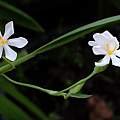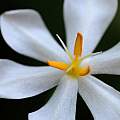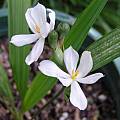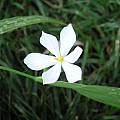Eleutherine is a genus in the Iridaceae family related to Tigridia. It is common in dry grasslands in subtropical areas of Central and South America and introduced in parts of India and Thailand, where the bulbs, which resemble small elongated red onions, are widely used in herbal medicine to treat coronary diseases. Some medical studies seem to confirm the effectiveness of certain naphthalene derivates found in them.
Unlike many other Tigridieae, the flowers are of little use in distinguishing the species, which lead to several described varieties which were reduced to the two featured here in 1991 by Goldblatt & Snow. Besides the white, +- equal petals, all Eleutherines feature an (in Tigridieae) unusually large cauline leaf. They will need a warm climate to thrive.
Eleutherine bulbosa Miller (syn E. americana, E. anomala, E. longifolia, E. palmifolia, E. plicata, E. subaphylla). The typical flowers are formed on several rhipidia with secondary branching, open in the evening for about three hours and have no notable scent. Most plants in cultivation and all from Asia are sterile, while most fertile plants were found in Peru. If they set seed, the capsules are globose. Photos by Martin Bohnet of plants obtained from Thailand.
Eleutherine latifolia Standley & Williams (syn E. citrodora), from Argentina via Plant Delights Nursery. Flowers on few rhipidia all originating from the cauline leaf are 3 cm in diameter, scented and open in the evening, but are completely shriveled by morning. Photos taken July 2004 by Lee Poulsen. Formerly identified as "Eleutherine americana" by the supplier, the scent, the elongated seed capsules and the fertility all hint towards E. latifolia.



